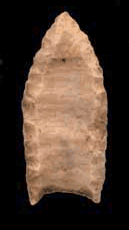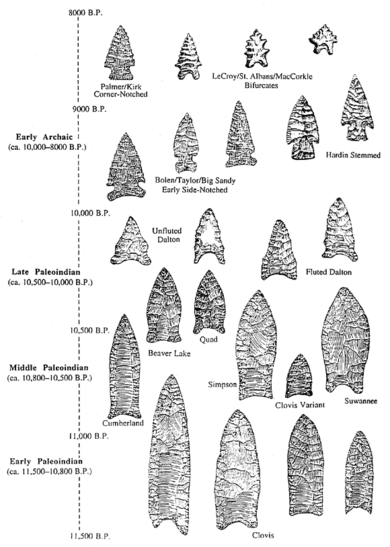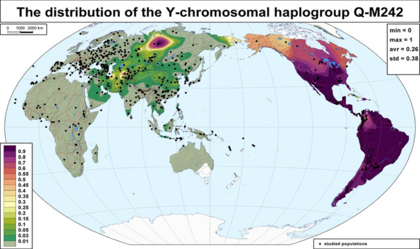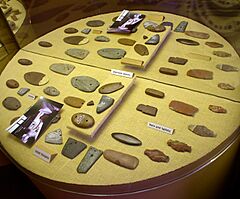Paleo-Indians facts for kids
| Paleo-Indians hunting a glyptodont Heinrich Harder (1858–1935), c. 1920. The Paleo-Indians, also known as the Lithic peoples, are the earliest known settlers of the Americas; the period's name, the Lithic stage, derives from the appearance of lithic flaked stone tools. |
Paleo-Indians were the very first people to live in the Americas. They arrived at the end of the Late Pleistocene period, which was a long time ago. The word paleo- means old or ancient in Greek. So, Paleo-Indians means "ancient Indians." This name is used for the time when people first used stone tools in the Americas.
Many scientists believe these early hunters crossed a land bridge called Beringia. This bridge connected North Asia (Siberia) to Alaska. It existed between 45,000 and 12,000 years before the year 2000. Small groups of hunter-gatherers followed large plant-eating animals into Alaska.
Around 16,500 to 13,500 years before the year 2000, paths opened up. These "ice-free corridors" appeared along the Pacific coast and in valleys. This allowed animals, and then humans, to move south. People traveled on foot or by boat along the coast. The exact dates and routes of how people first came to the Americas are still being studied. It is thought there were three main groups of settlers.
We know about Paleo-Indians mostly from their Stone tools. These include projectile points (like spear tips) and scrapers. Archeologists study these tools to understand different time periods. DNA evidence also shows that Native Americans are related to people from eastern Siberia. This suggests there were at least two separate migrations.
Paleo-Indians lived alongside huge animals called megafauna. Most of these large animals died out around the end of the Paleo-Indian period. This was part of the Late Pleistocene megafauna extinctions. Scientists still debate if human hunting caused these extinctions, or if climate change was the main reason.
From 8000 to 7000 years before the year 2000, the climate became more stable. This led to more people and better stone tool technology. People started to live in one place for longer periods. This led to the next period, called the Archaic Period.
Contents
How People Migrated to the Americas
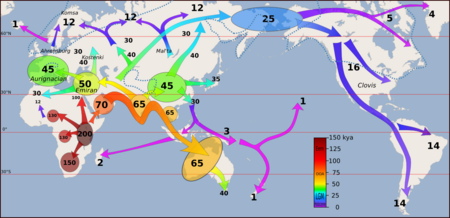
Scientists are still learning about how Paleo-Indians moved into and across the Americas. The most common idea is that they crossed the Beringia land bridge. This bridge was between Siberia and Alaska. It appeared about 17,000 years ago when sea levels were much lower.
These early people likely followed herds of large animals that are now extinct. They moved through paths that were free of ice. These paths were between the huge Laurentide and Cordilleran ice sheets.
Another idea is that people traveled down the Pacific coast. They might have walked or used boats. Evidence of this coastal journey would now be underwater. This is because sea levels rose a lot after the last Ice Age ended.
The exact time when humans arrived in North America is still debated. Most experts think it was between 15,000 and 20,000 years ago. However, some groups might have reached South America as early as 25,000 years ago. Most agree that people came from Siberia. They spread across the Americas after the peak of the last Ice Age, about 16,000 to 13,000 years ago.
Paleo-Indian Life and Times
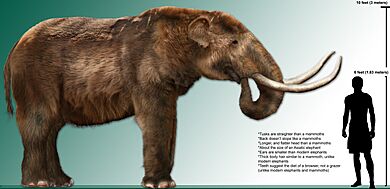
Some of the oldest signs of Paleo-Indians are found in Alaska. Then, signs appear in British Columbia, Alberta, and the Yukon. Eventually, Paleo-Indians lived all over the Americas. They lived in many different places, so their lifestyles varied.
However, all these groups made stone tools in a similar way. This helps archeologists identify their culture. These early Paleo-Indians were very mobile. They lived in small groups of about 20 to 60 family members.
Food was plentiful during the warmer months. Lakes and rivers had many fish, birds, and water animals. Forests and marshes offered nuts, berries, and edible roots. Fall was a busy time for storing food and making warm clothes for winter. During winter, coastal fishing groups moved inland to hunt and trap.
Changes in the ice-age climate caused plants and animals to move. People followed these resources. Small groups hunted and gathered in spring and summer. Then, they split into smaller family groups for fall and winter. Families moved every 3 to 6 days, sometimes traveling up to 360 kilometers a year.
Their diets were rich in protein. Clothing and shelters were made from animal hides. For much of the early and middle Paleo-Indian periods, inland groups hunted large, now-extinct animals. These included the giant beaver, steppe wisent, giant muskox, mastodon, woolly mammoth, and ancient reindeer.
The Clovis culture is one of the most famous Paleo-Indian groups. They appeared around 11,500 years before the year 2000 in North America. It's debated if they only hunted large animals or also ate smaller game, fish, and plants.
Paleo-Indian groups were skilled hunters. They used many tools. These included special fluted-style spear points. They also used microblades for butchering animals and processing hides. Stone tools were often traded or moved far from where they were made. For example, tools have been found from North Dakota to Montana.
The glaciers covering the northern continent slowly melted. This opened up new land for people to live on. This happened about 17,500 to 14,500 years ago. At the same time, many large mammals around the world started to die out. In North America, camels and horses disappeared. Horses did not return until the Spanish brought them back in the late 1400s. As these extinctions happened, late Paleo-Indians found other ways to get food.
From about 10,500 to 9,500 years before the year 2000, hunters on the Great Plains focused on one animal: the bison. The Folsom tradition is the earliest known group of these bison hunters. Folsom people traveled in small family groups. They would return yearly to favorite spots like springs. There, they might camp, make tools, or process meat before moving on. Paleo-Indians were not very numerous, so there were not many people in any one area.
Types of Paleo-Indian Tools
Paleo-Indians are often grouped by the style of their stone tools. These tools, especially spear points, are called projectile points. They were made by chipping stone to create a long groove, or "flute." The point was then tied to a wooden or bone spear.
As the Ice Age ended, around 17,000 to 13,000 years ago, many animals moved to new food sources. Humans followed these animals, like bison, mammoths, and mastodons. This is why they are called "big-game hunters." People living along the Pacific coast likely relied on fishing for food.
Archeologists are finding evidence that humans settled in North America even earlier. Some signs suggest people were in Beringia before 30,000 years ago. For a long time, it was thought that the Clovis culture was the first Paleo-Indian group in North America. This culture is named after Clovis, New Mexico. In 1936, unique Clovis points were found there with bones of Ice Age animals.
However, new discoveries suggest that people were in the Americas much earlier. Sites like Cooper's Ferry in Idaho and Monte Verde in Chile show very old dates for Paleo-Indian settlements. Some of these sites are older than the time when ice-free paths were available. This suggests that people might have used coastal routes, either by walking or using boats. Geological evidence shows the Pacific coastal route was open before 23,000 years ago and after 16,000 years ago.
Paleo-Indians in South America
In South America, the site of Monte Verde shows that people probably stayed in their river basin most of the year. Other groups in South America moved around a lot. They hunted large animals like gomphotheres (like elephants) and giant sloths. They used special spear points called Fishtail points.
Some examples of these groups include those using El Jobo points in Venezuela. Fishtail points were used in many parts of the continent, especially the southern half. Paijan points were found in Peru and Ecuador. These groups lived in grasslands, savannas, and forests.
The dates for these sites range from about 14,000 years ago (for Taima-Taima in Venezuela) to about 10,000 years ago. The El Jobo spear points were found mostly in northwestern Venezuela. People using them were hunter-gatherers who stayed in a certain area. El Jobo points are thought to be very old, from about 14,200 to 12,980 years ago. They were used for hunting large mammals. Fishtail points, dating to about 11,000 years ago in Patagonia, were found over a much wider area. They were mostly in the central and southern parts of South America.
Genetic History of Paleo-Indians
Scientists study DNA to understand how people moved around the world. The most common haplogroup (a group of genes passed down) linked to Native Americans is Haplogroup Q-M3. Y-DNA, which is passed down from father to son, helps scientists track ancient family lines.
The DNA patterns show that Native Americans went through two main genetic changes. The first was when they first settled the Americas. The second was when Europeans arrived. The first event determined how many different genetic lines are found in Native American groups today.
Human settlement of the Americas happened in stages from the Bering Sea coast. The first group of people stayed in Beringia for a while. DNA evidence from South America shows that some Native American groups have been isolated since they first settled there.
However, groups like the Na-Dené, Inuit, and Indigenous Alaskan populations have different DNA markers. This suggests that the people who first moved into northern North America and Greenland came from later groups of migrants.
Studies of full genomes suggest that the first people in the Americas separated from ancient East Asians about 36,000 years ago. They then moved north into Siberia. There, they met and mixed with another group of ancient Siberians. This mixing led to the ancestors of both Paleosiberian peoples and Ancient Native Americans. These groups later moved towards the Beringian region, became isolated, and then populated the Americas.
Why Did Large Animals Disappear?
Paleo-Indians hunted many large animals that are now extinct. After a period when humans and these animals lived together, most large animals in the Americas died out. This was part of the Late Pleistocene megafauna extinctions.
Many scientists believe that hunting by Paleo-Indians played a big role in these extinctions. However, this idea is still debated. Other scientists think that climate change was the main reason these animals disappeared. In a 2012 survey, 63% of archeologists said that the extinctions were likely caused by "a combination of factors."
Moving Towards the Archaic Period
The Archaic period in the Americas brought big changes. The climate became warmer and drier. The last of the megafauna disappeared. Most people were still mobile hunter-gatherers. But now, groups started to focus on the resources available in their local area.
Over time, people developed different ways of life based on their region. Examples include the Southwest, Arctic, Poverty, Dalton, and Plano traditions. These regional adaptations became common. People relied less on just hunting and gathering. They developed a mixed economy of small game, fish, wild vegetables, and harvested plants.
Many groups still hunted large animals. But their hunting methods became more varied and advanced. Finding artifacts in Archaic burial sites also shows that some groups had social differences based on status.
See also
 In Spanish: Paleoamericano para niños
In Spanish: Paleoamericano para niños


